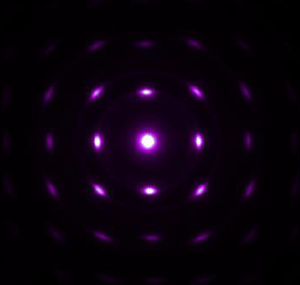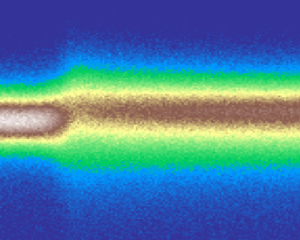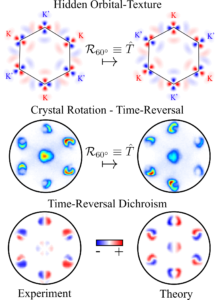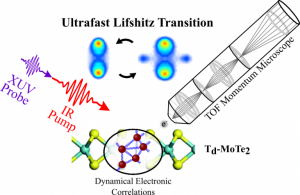Home
Welcome to the Dynamics of Correlated Materials group!
We are an experimental research group focusing on the investigation of ultrafast processes in strongly correlated materials. Our goal is the understanding of the fundamental interactions at play on the microscopic level in such materials, leading to complex behavior. We develop and employ complementary ultrafast techniques such as time- and angle-resolved photoelectron spectroscopy (trARPES) and time-resolved diffraction techniques to study those elementary interaction processes and couplings across ultrafast phase transitions.
News
New group member: Jit Sarkar
Nov 2020

We are happy to welcome our new Postdoc Jit Sarkar to the group!
New preprint: Ultrafast lattice of the antiferromagnet nickel oxide
Nov 2020

We use femtosecond electron diffraction to study ultrafast lattice dynamics in the highly correlated antiferromagnetic semiconductor NiO. Using the scattering vector (Q) dependence of Bragg diffraction, we introduce a Q-resolved effective lattice temperature and identify a nonthermal lattice state with a preferential displacement of O compared to Ni ions, which occurs within ~0.3 ps and persists for 25 ps. We associate this with transient changes to the antiferromagnetic exchange striction-induced lattice distortion, supported by the observation of a transient Q-asymmetry of Friedel pairs. Our observation highlights the role of spin-lattice coupling in routes towards ultrafast control of spin order.
arXiv:2011.07289 (2020)
arXiv:2011.07289 (2020)
Time-resolved core-level spectroscopy reveals exciton dynamics.
Aug 2020

Optoelectronic applications root on excited electronic states. In semiconductors, there are two types of excited states: many-body states like bound electron-hole states, so-called excitons, and simpler quasi-particle states, typically referred to as quasi-free carriers (QFCs). In general, both types coexist in a dynamical interplay of exciton and QFC populations.
Using the free-electron laser Flash at Desy in Hamburg in conjunction with a time-of-fligh momentum microscope, we were able to track the time-dependent electronic structure of the layered semiconductor WSe2 on an ultrafast timescale. Our findings demonstrate a novel, at first glance counter-intuitive approach for accessing exciton and QFC dynamics on ultrafast time scales: the photoemission lineshapes of core levels, i.e. states deep below the frontier orbitals, turn out to be sensitive probes of the electron dynamics occurring in the valence and conduction band. [more...]
Using the free-electron laser Flash at Desy in Hamburg in conjunction with a time-of-fligh momentum microscope, we were able to track the time-dependent electronic structure of the layered semiconductor WSe2 on an ultrafast timescale. Our findings demonstrate a novel, at first glance counter-intuitive approach for accessing exciton and QFC dynamics on ultrafast time scales: the photoemission lineshapes of core levels, i.e. states deep below the frontier orbitals, turn out to be sensitive probes of the electron dynamics occurring in the valence and conduction band. [more...]
Time-Reversal Dichroism in ARPES
Jun 2020

Angle-resolved photoemission spectroscopy (ARPES) is the most direct technique to probe the electronic structure of crystalline solids. While ARPES is typically used to map the bands’ dispersion, increasing the dimensionality of the measurements, and thus of the observables, have been shown to provide more subtle information about the electronic wavefunction of solids. In this joint experimental and theoretical work (in collaboration with J. Braun, H. Ebert, K. Hricovini, J. Minar and M. Schüler), we introduce a new observable in ARPES, Time-Reversal Dichroism in Photoelectron Angular Distributions (TRDAD). This novel observable quantifies the modulation of the photoemission intensity upon azimuthal crystal rotation which mimics a time-reversal operation. We demonstrate that this observable allows accessing the hidden orbital pseudospin texture in bulk 2H-WSe2.
S. [more...]
S. [more...]
Ultrafast Light-Induced Lifshitz Transition
Mar 2020

In crystalline solids, electrons fill quantum-mechanically allowed states from the lowest possible energy upwards, a consequence of the Pauli exclusion principle. The energy of the highest occupied state is known as the Fermi energy. Because electrons within solids have well-defined three-dimensional momenta, one can plot components of these momenta against each other, for electron lying at the Fermi energy, leading to characteristic and often beautiful shape, bounded by a so-called Fermi surface.
The Fermi surface is “the stage where the drama of the life of the electron is played out,” wrote famous physicists Lifshitz and Kaganov, in 1980. Indeed, the shape of the Fermi surface governs most of the properties of metals and strongly correlated many-body systems. Equilibrium tuning of macroscopic parameters such as temperature, pressure, strain or doping has recently been established as robust tools to modify the Fermi surface [more...]
The Fermi surface is “the stage where the drama of the life of the electron is played out,” wrote famous physicists Lifshitz and Kaganov, in 1980. Indeed, the shape of the Fermi surface governs most of the properties of metals and strongly correlated many-body systems. Equilibrium tuning of macroscopic parameters such as temperature, pressure, strain or doping has recently been established as robust tools to modify the Fermi surface [more...]